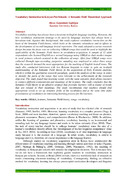Vocabulary Instruction in Kenyan Pre-Schools: A Semantic Field Theoretical Approach
Abstract
Vocabulary teaching has always been a keystone in English language teaching. However, the best vocabulary instruction strategy to be used by language teachers has always been a herculean task. Against this background, this study explores vocabulary instruction on the basis of the Semantic Field theory, which looks at the semantic relatedness and its effects in the development of second language lexical repertoire. The study adopted a survey research design because the focus was on collecting Gĩkũyũ songs that could be used to highlight the applicability of the Semantic Field theory in vocabulary acquisition. A sample of 12 adult
respondents who learned English as a second language using Gĩkũyũ as their mother tongue in rural primary schools assisted in the collection of songs. After four Gĩkũyũ songs were collected through tape-recording, purposive sampling was employed to select three songs that the research deemed the most appropriate for the teaching of English lexical items. The study also conducted interviews with two Kenyan linguists in order to gain an in-depth understanding of the Semantic Field theory in the acquisition of lexis. Content analysis, which is within the qualitative research paradigm, guided the analysis of the songs in order
to identify the parts of the songs that were relevant to the achievement of the research objective. The study found that learning words with the same semantic field allows learners to connect different connotations and meanings of the lexemes. The study concludes that the Semantic Field theory is an effective strategy that provides learners with a cluster of words
that are related in their meanings. The study recommends that teachers should find appropriate words to set up semantic fields of the vocabulary and at the same time make presentation of vocabulary an interesting learning process for the learners.
